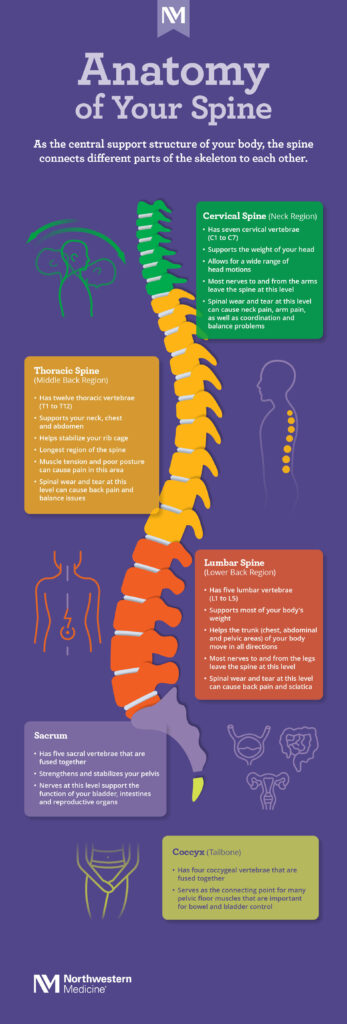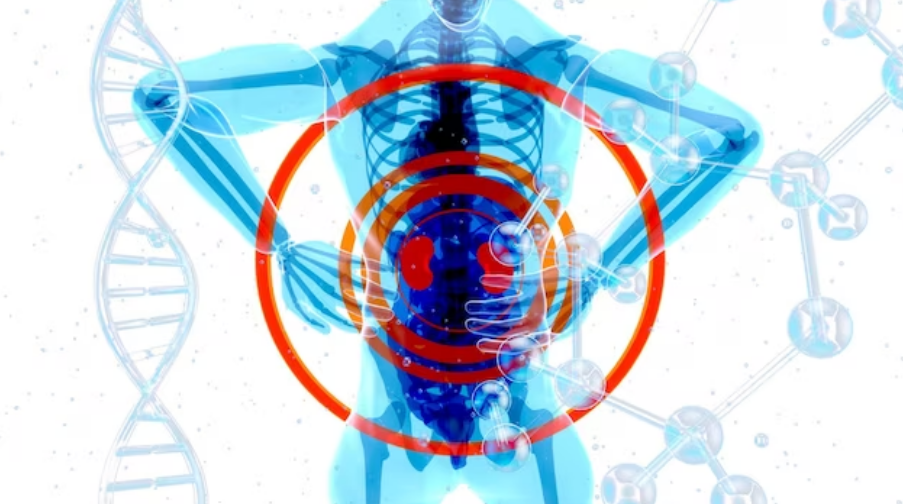As the term states, spinal manipulation focuses on the spine. Its role in supporting our body’s structure and safeguarding the nervous system cannot be overstated. Within this intricate system of bones, discs, and nerves lies the potential for both harmony and disarray.
In this blog, we focus on a technique known as High-Velocity, Low-Amplitude Thrusts (HVLA). These maneuvers, performed by skilled healthcare professionals, seek to optimize the alignment and mobility of the spine. By understanding the art and science of HVLA spinal manipulation, we can appreciate its potential to alleviate pain, improve mobility, and enhance our overall health.
Understanding Spinal Anatomy
The spine, also known as the backbone, is a remarkable and complex structure that plays a crucial role in supporting our bodies and protecting a vital part of our nervous system. It is composed of a series of bones stacked on top of each other, called vertebrae. These vertebrae are not just any bones; they are uniquely designed to allow flexibility and movement while maintaining stability.
- Cervical Vertebrae (Neck): These are the seven small vertebrae in your neck, responsible for supporting your head’s weight and allowing you to turn, nod, and shake your head.
- Thoracic Vertebrae (Upper Back): The twelve thoracic vertebrae are attached to your ribs, forming the middle portion of your spine. They provide structural support and protect vital organs like your heart and lungs.
- Lumbar Vertebrae (Lower Back): The five lumbar vertebrae are the largest and strongest. They bear the brunt of your body weight and facilitate movements like bending and lifting.
- Sacrum and Coccyx (Tailbone): These are the fused bones at the base of your spine, providing support for your pelvis and lower body.

Between each pair of vertebrae, you’ll find something like a cushion or shock absorber called an intervertebral disc. These discs are made up of tough, fibrous outer layers and a gel-like center. Their primary role is to:
- Absorb Shock: When you walk, jump, or move, these discs help absorb the impact, preventing your vertebrae from grinding against each other.
- Facilitate Movement: They allow your spine to bend and flex, providing the flexibility necessary for daily activities.
- Maintain Space: Discs create space between vertebrae, which is critical for nerves that exit the spinal cord. This space prevents nerve compression and ensures proper communication between your brain and the rest of your body.
One of the spine’s most crucial roles is to protect the nervous system. Your spinal cord, an extension of your brain, runs through the central canal formed by the vertebrae. Along the length of your spinal cord, nerves branch out, like a complex network of electrical wiring.
These nerves are responsible for transmitting messages between your brain and the rest of your body. They control your movements, sensations, and even involuntary processes like breathing and digestion. Without a properly functioning nervous system, your body simply wouldn’t work.
High-velocity, low-amplitude thrusts, as used in spinal manipulation, aim to optimize the alignment and mobility of your vertebrae. When your spine is in good shape, it can better protect the delicate spinal cord and ensure that your nerves can transmit messages without interruption. This not only reduces pain and discomfort but can also enhance your overall health and well-being.
Indications for HVLA Thrusts
High-Velocity, Low-Amplitude Thrusts (HVLA) is a spinal manipulation technique with a rich history of effectively addressing various health concerns.
It is frequently employed to manage pain associated with musculoskeletal conditions, joints, sciatica, whiplash, and scoliosis. While HVLA thrusts cannot “cure” scoliosis, they can be part of a comprehensive treatment plan to manage discomfort and improve spinal function in some cases.
Before undergoing HVLA thrusts, like every medical treatment or visit to a healthcare provider, a thorough assessment and diagnosis is essential. The patient’s health history is gathered, a physical examination (including orthopedic and neurological tests) is done, X-rays or other imaging may be required, and of course, the patient’s descriptions of their symptoms and pain.
While HVLA thrusts can be highly effective, they are not suitable for everyone and require careful consideration of safety precautions and contraindications. It’s essential to consult with a qualified healthcare professional for personalized advice regarding HVLA thrusts and their suitability for your specific situation.
Spinal Manipulation Benefits and Efficacy
Pain Relief: HVLA thrusts can provide significant relief from various types of back and neck pain, including muscle tension, joint discomfort, and nerve-related pain. This is achieved by restoring proper alignment and reducing pressure on pain-sensitive structures.
Improved Mobility: Stiffness and restricted movement often accompany spinal issues. HVLA thrusts can enhance joint flexibility and range of motion. This increased mobility contributes to a better quality of life, allowing you to perform daily activities with greater ease.
Central Nervous System Impact: Your spine houses the spinal cord, a crucial part of the central nervous system. When the spine is misaligned, it can interfere with the transmission of nerve signals. Spinal manipulation HVLA adjustments can help realign the spine, promoting unimpeded communication between the brain and the rest of the body.
Spinal Manipulation Risks and Side Effects
Muscle or Ligament Strain: During a high-velocity, low-amplitude thrust, the quick movement can occasionally lead to strains in the surrounding muscles or ligaments. This might result in some discomfort post-treatment.
Fractures or Dislocations: In rare cases, particularly when dealing with pre-existing conditions like osteoporosis, there is a small risk of fractures or dislocations. This risk is why thorough patient evaluation is crucial before proceeding.
Nerve Irritation: The rapid movement during spinal manipulation could irritate nearby nerves, potentially causing tingling sensations or, in extremely rare cases, more severe nerve-related issues.
As we conclude our blog on the art of spinal manipulation, whether you are considering spinal manipulation HVLA thrusts or exploring alternative therapies under chiropractic care, the key lies in informed choices and a partnership with healthcare providers who prioritize your health and safety.
Disclaimer: The information in this blog should not be used to self-diagnose or self-treat any medical condition. Any decision related to spinal manipulation or healthcare should be made in consultation with a qualified healthcare provider who can provide individualized advice, considering your medical history, current health status, and specific needs.

